We at UMM are having our yearly HHMI-sponsored summer research program. In addition to having undergraduates working away in our labs, we also have some more social activities — and yesterday we joined with the science students at the Morris public schools for a bottle rocket launch.
No, not that kind of bottle rocket. In this case, they using two liter plastic bottles, filling them up with some water, and then pumping them up with air pressure. Then…whoosh, off they go. The rockets were also assembled with fins and nose cones and those traditional bits. The elementary and middle school kids had to deal with various constraints — they had “budgets”, and had to “pay” for every bit of cardboard and duct tape they stuck on their bottles, and also for the water fuel and the amount of pressure they put in the bottles. They also had specific goals: distance traveled, time aloft, that sort of thing. Our HHMI students had no constraints, so it was a little unfair. They weren’t part of the competition, though, and the kids whose rockets outperformed the college students’ got extra points on their victory, so it was OK.
The UMM rockets did pretty well, but yeah, some of the kids’ rockets with their minimal approach did do better.
Here’s our first pair of rockets getting ready to launch.
Blast off!
Here’s our second pair. You can see that the launching frame is a bit more elaborate than I expected. There was also a strict safety protocol in place.
Another successful launch.
I caught this one in flight — you can see it against the background of the water tower. This one actually cleared the chain link fence off in the distance.
And here’s our ground crew.


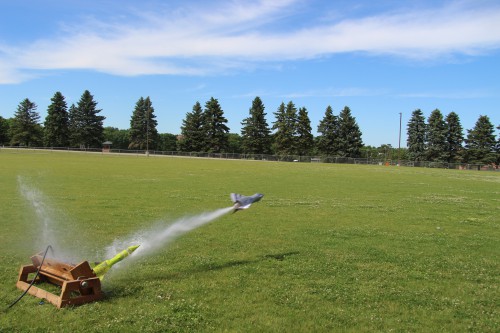
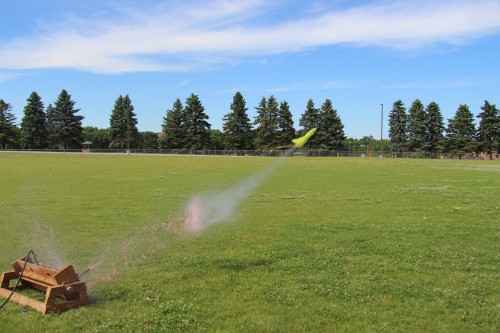
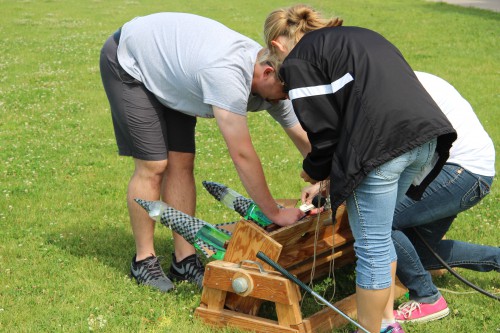
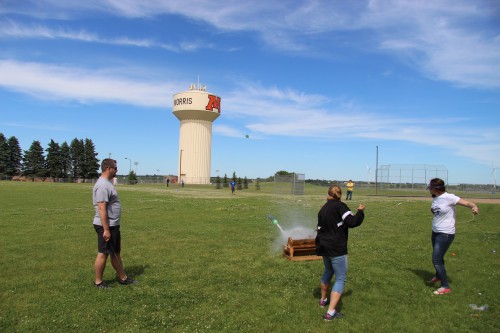

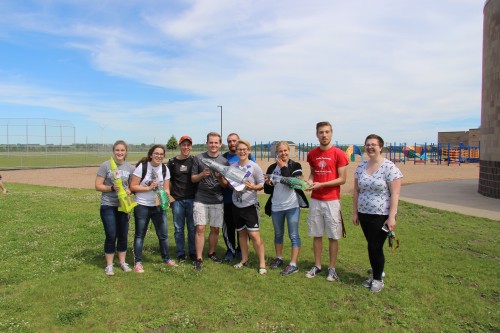

Random curiosity – has there been any significant uptick in the performance of the pre-college students’ rockets since, say, 2014?
Don’t know. This is the first time we’ve participated.
Probably not, though. A lot of the rockets being launched by the kids were highly experimental: weird things with wings, and the loft time group had a bunch with balloons attached. There were also construction problems — some of them simply disintegrated in a flurry of duct tape and cardboard at launch.
Aww.
*sadly ticks the “KSP has not created a generation of expert rocketeers” box*
Still, there’s always time. My hope is that, by 2020, every 6 year old will be capable of building their own space-worthy rocket and visiting the moon – if not Mars! – over the course of a rainy weekend.
I’m a fan of Keigo Higashino, a main character in his mystery novels is a physics professor. In his latest, A Midsummer’s Equation, a bottle rocket played a prominent part, and the descriptions of it were great, as was the purpose of it.
@3 Athywren – I don’t think KSP really teaches rocket design any better than Lego teaches bridge building. One may pick up some basics of drag and balance, but the only application here would be simpler rockets that are designed like a dart. I sincerely doubt any of the younger competitors would worry about shifting center of mass or anything in a bottle rocket.
That’s not to slam KSP. While the building rockets side of the game is light on education value, the orbital mechanics side is amazing. It just helps foster a sense of how things move and how to get where you’re going in space, in a way none of my college courses did. And it’s way more fun.
Athywren. I wouldnt expect much of a change in pre-college students without them copying others designs. Its a surprisingly complicated problem with many points of failure. Its one of the best learning exercises I’ve seen.
It should be noted that one of these can easily be lethal.
I’m sorry, PZ, I don’t understand. Where’s Elon Musk? I don’t see him in the pictures anywhere! Did he try to shut down your program? Afraid of the competition, was he?
KSP gets people excited about rockets, so I’d expect more kids building model rockets. If they can tear themselves away from the game anyway.
“[A] strict safety protocol” that left the municipal water supply in the direct line of the launch trajectory?
Y’all live dangerously in Morris!
Students should read “Rockets, Missiles, and Men in Space” by Willy Ley. Still topical, copy write 1968!
As an actual rocket scientist, by education (BS Aerospace Engineering), I approve.
Water rockets were some of my favorite toys growing up. Glad to see people are still enjoying them.
On a related note, here’s a whole channel of water rockets being taken very seriously: https://www.youtube.com/channel/UCqOcPn8fVKqyxz9K0H6LQpg
Crimson Clupeidae:
It’s not exactly brain surgery, though, is it?
I did that in Science Olympiad. For whatever reason, if you just had a straight 2-liter bottle, no fins, no nothing, it stayed in the air longer.
I think it was just that it was windy that day.
In 7th Grade (this would be circa 1988) we built model rockets entirely from scratch. We rolled our own body tubes, made engine mounts from index card and cardboard, cut parachutes from garbage bags, etc.. The only thing that was pre-made was the single Estes A8-3 motor we each given.
My rocket went up, but the parachute failed to deploy.
@ 13 Moggie
OK, that’s a main engine burn right there.
Speaking of rockets, we’ve been seeing a lot of SpaceX, but yesterday I found this as well: https://www.blueorigin.com/
I’m becoming a big fan of commercial enterprises racing to space right now. This is a fun time to watch the evolution of space flight beginning to take shape.
Did anyone try fitting the rocket with a parachute to keep it in the air longer? Seems like you could make some kind of cone that would make the parachute deploy automatically as soon as the rocket loses momentum and starts falling.
Soda-bottle rockets are fun. You can make your own launcher easily (there are many examples on the web—including mine at https://users.soe.ucsc.edu/~karplus/abe/soda-bottle-rocket.pdf or https://users.soe.ucsc.edu/~karplus/abe/soda-bottle-rocket-spanish.pdf if you prefer it translated into Spanish).
I’ve done soda bottle launchings at elementary schools off and on for 14 years, and they are always fun. I’ve also used them as part of home-school high-school physics course, and tried doing a little modeling of them: https://gasstationwithoutpumps.wordpress.com/2012/06/04/soda-bottle-rocket-simulation-take-2/
and some measurements:
https://gasstationwithoutpumps.wordpress.com/2012/06/10/homemade-super-pulley/
Moggie@13: It’s rocket surgery!!
…or something. :)
When I worked for Boeing in Seattle, I was part of the 8th grade after school science project and this was one of the things we did. Those were fun projects (other things were building a ‘chair’ out of newspaper that had to hold a science book, building a boat with nothing but straws and cellophane, that had to hod 10 pennies,…stuff like that).
KSP taught me space is big.
Okay, like, any physics class I took (not many mind you) said space was big. And they tried visual metaphors to tell me how big, but it never stuck.
I don’t think you appreciate big until you try a very simple experiment: run a KSP mission without fast forwarding.
Big.